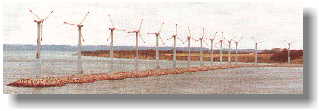
Wind is simple air in motion. It is caused by the uneven heating of the earth's surface by the sun. Since the earth's surface is made of very different types of land and water, it absorbs the sun's heat at different rates.
During the day, the air above the land heats up more quickly than the air over water. The warm air over the land expands and rises, and the heavier, cooler air rushes in to take its place, creating winds. At night, the winds are reversed because the air cools more rapidly over land than over water.

In the same way, the large atmospheric winds that circle the earth are created because the land near the earth's equator is heated more by the sun than the land near the North and South Poles.
Today, wind energy is mainly used to generate electricity. Wind is called a renewable energy source because the wind will blow as long as the sun shines.
Since ancient times, people have harnessed the winds energy. Over 5,000 years ago, the ancient Egyptians used wind to sail ships on the Nile River. Later, people built windmills to grind wheat and other grains. The earliest known windmills were in Persia (Iran). These early windmills looked like large paddle wheels.


Like old fashioned windmills, today's wind machines use blades to collect the wind's kinetic energy. Windmills work because they slow down the speed of the wind. The wind flows over the airfoil shaped blades causing lift, like the effect on airplane wings, causing them to turn. The blades are connected to a drive shaft that turns an electric generator to produce electricity.
Wind power plants, or wind farms as they are sometimes called, are clusters of wind machines used to produce electricity. A wind farm usually has dozens of wind machines scattered over a large area...
 ....................
....................Operating a wind power plant is not as simple as just building a windmill in a windy place. Wind plant owners must carefully plan where to locate their machines. One important thing to consider is how fast and how much the wind blows.
As a rule, wind speed increases with altitude and over open areas with no windbreaks. Good sites for wind plants are the tops of smooth, rounded hills, open plains or shorelines, and mountain gaps that produce wind funneling.
ADVANTAGES
Wind is a clean fuel, and wind farms produce no air or water pollution, because no fuel is burned. Wind is free, and wind farms need no fuel. The land under the wind machines can usually still be used for farming, and wind farms can also be tourist attractions. It is a good way of supplying energy to remote areas.
And wind power is renewable. Winds will keep on blowing, so it makes sense to use them.
DISADVANTAGES
The most serious drawbacks to wind machines may be their impact on wild bird populations (they fly into the wind machines,which kill them), and also the fact that some people see them as an eyesore. They are very big, and you certainly notice them! People don't want to live too close to a wind farm either, because the machines can be quite noisy, making a low swooshing noise all day and night, which can drive people nuts. It can also interfere with television reception.
The wind is not always predictable, because some days have no wind at all. Some areas where it is windy enough to have a wind farm are near the sea, where the land is very expensive, and people don't want windfarms nearby. NIMBY - not in my back yard!